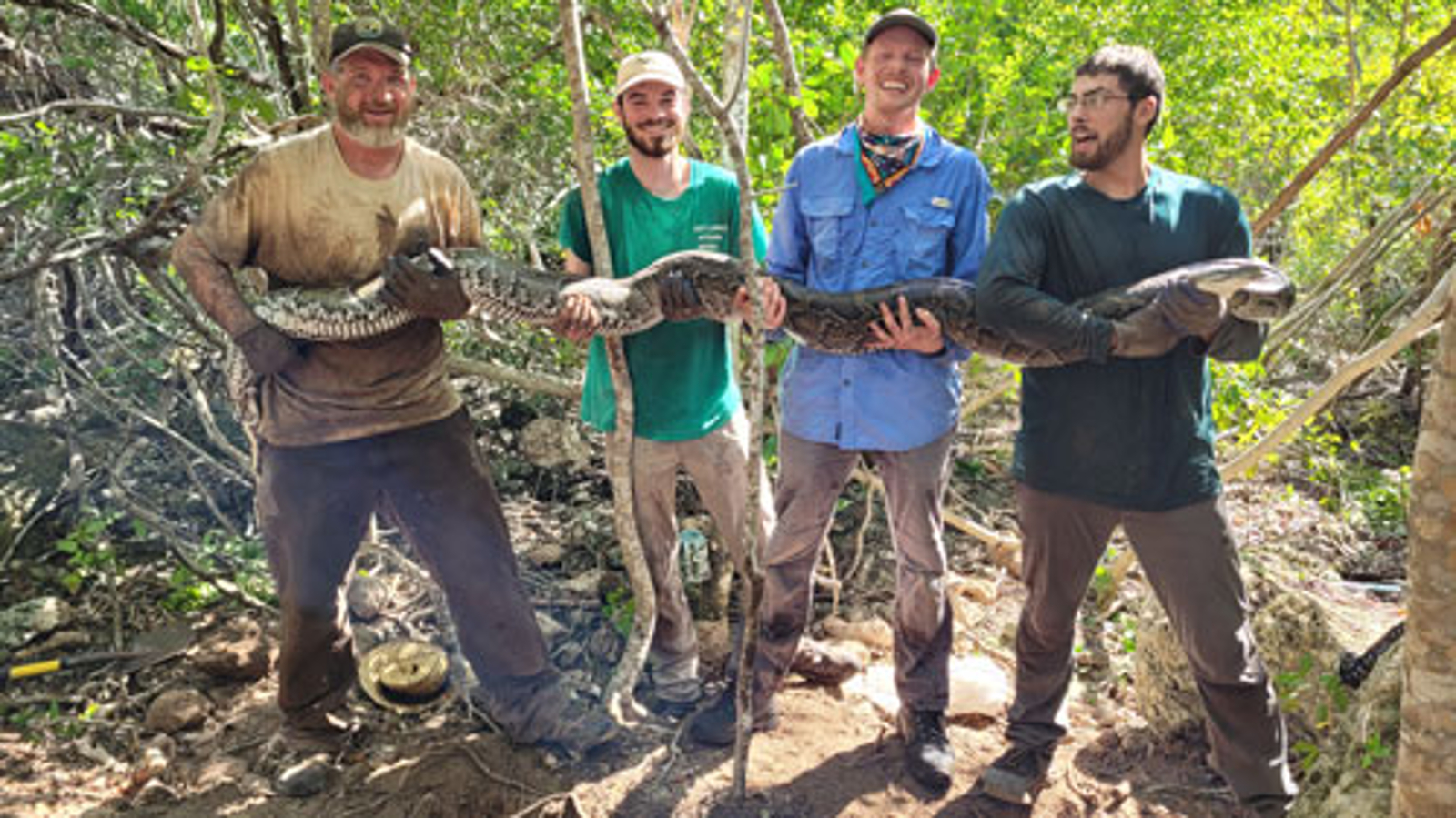GPS-tagged possums and raccoons could be sacrificed to capture Florida's invasive pythons
Researchers accidentally discovered that GPS-tagged mammals can help locate Florida's invasive Burmese pythons, which are destroying local ecosystems.

Researchers have stumbled across an effective new way of finding giant Burmese pythons, which are invasive to the U.S. and have been decimating Florida's local ecosystems.
While carrying out an unrelated study into the movements and behaviors of raccoons and possums in Key Largo, an island off the southern Florida coast, researchers found that the GPS collars they attached to the small mammals could track the invasive Burmese pythons (Python bivittatus) after the supersized snakes swallowed the tagged animals whole.
The team first made this serendipitous discovery in September 2022, when a GPS collar attached to a possum gave off a mortality signal, which is emitted when an animal goes several hours without moving when it should be active. But after a few hours, the collar began to move again. Over the next few days, the collar emitted several other mortality signals between short periods of movement. The researchers realized that the only explanation for this unusual behavior was if the possum had been eaten by a python, the researchers wrote in a statement.
After tracking the collar for around a month, the team found the python, a 12-foot-long (3.7 meters) female weighing a hefty 66 pounds (30 kilograms), which was then euthanized. A necropsy of the snake revealed that the GPS collar was still intact and fully functional inside the snake, even though the possum had long been digested, the researchers wrote in the statement.
Related: Jaw-dropping study reveals how pythons can devour super-size prey

In January, researchers successfully tracked another python, a 77-pound (35 kg) female of unknown length, after the girthy serpent swallowed a raccoon with a GPS collar. And on Feb. 8, the researchers tracked down another GPS collar in a pile of snake poop, which had only recently been passed by another large python, The South Florida Sun-Sentinel reported.
In total, three of the 42 GPS collars attached to mammals by researchers have been ingested by snakes, and another six have gone missing. Although it's not possible to definitively say what happened to the missing collars, the researchers suspect that pythons have swallowed them and since moved outside of the study area.
Sign up for the Live Science daily newsletter now
Get the world’s most fascinating discoveries delivered straight to your inbox.
Pesky pythons
Burmese pythons are massive serpents from Southeast Asia that invaded Florida in the early 1970s after being released as part of the exotic pet trade. The largest Burmese python found in Florida so far was an 18-foot-long (5.5 m) giant weighing a scale-tipping 215 pounds (98 kg) that was caught and killed in June 2022.
The pythons have been extremely damaging to Florida's ecosystems because they are voracious eaters, reproduce rapidly and have no natural predators. As a result, wildlife officials are legally required to kill the snakes if they find them in the wild (and it is safe to do so).
Related: Gruesome video reveals the moment a 5-foot alligator corpse was cut from the gut of a dead python
In certain areas, such as Everglades National Park, "there are no more mammals to put these collars on," because the snakes have decimated local populations, study researcher Michael Cove, curator of mammals at the North Carolina Museum of Natural Sciences in Raleigh, told The South Florida Sun-Sentinel.
In other areas, however, the new tracking technique might work, especially when it comes to locating the snakes in underground tunnels.
The team wants to continue using GPS collars to track Burmese pythons and are currently planning a new project with local agencies. "We need everything that we can find to remove as many pythons as possible," Cove said.

Harry is a U.K.-based senior staff writer at Live Science. He studied marine biology at the University of Exeter before training to become a journalist. He covers a wide range of topics including space exploration, planetary science, space weather, climate change, animal behavior and paleontology. His recent work on the solar maximum won "best space submission" at the 2024 Aerospace Media Awards and was shortlisted in the "top scoop" category at the NCTJ Awards for Excellence in 2023. He also writes Live Science's weekly Earth from space series.










